Is your iPhone stuck in Recovery Mode? Is it not responding to any of your efforts to make it work normally again? If the answer is yes, then you are in luck because this guide is precisely for you.
What is Recovery Mode?
Are you seeing the iTunes symbol or a computer icon on a black screen? That means your iPhone went into Recovery Mode.
It is a part of Apple’s bootloading mechanism, for all its devices, which is meant to be used as an intermediary safe place for the device to stay until the recovery or update process is initiated. This is why we see so many users get their iPhone into recovery mode during a failed update.
That bit of information, I am hoping, has cheered you up a little, knowing that recovery mode is meant to be a part of the iPhone’s very inner workings and not a malfunction that is irreparable.
Is Recovery Mode Common?
Yes. Recovery Mode is a pretty common error in the iPhone user community. We can guide you out of this situation if you just follow any one of these 5 methods that suits you.
Recently, my iPhone 14 Pro got stuck in recovery mode while I was trying to install a new iOS firmware update from Apple. Instead of updating its iOS, the iPhone just flashed a laptop symbol on the screen, and stayed that way.
So, I started searching online on my laptop what that meant. After a decent search, I found out on a forum that this meant my iPhone went into recovery mode. In there, I also found out that there are several methods to get an iPhone out of recovery mode.
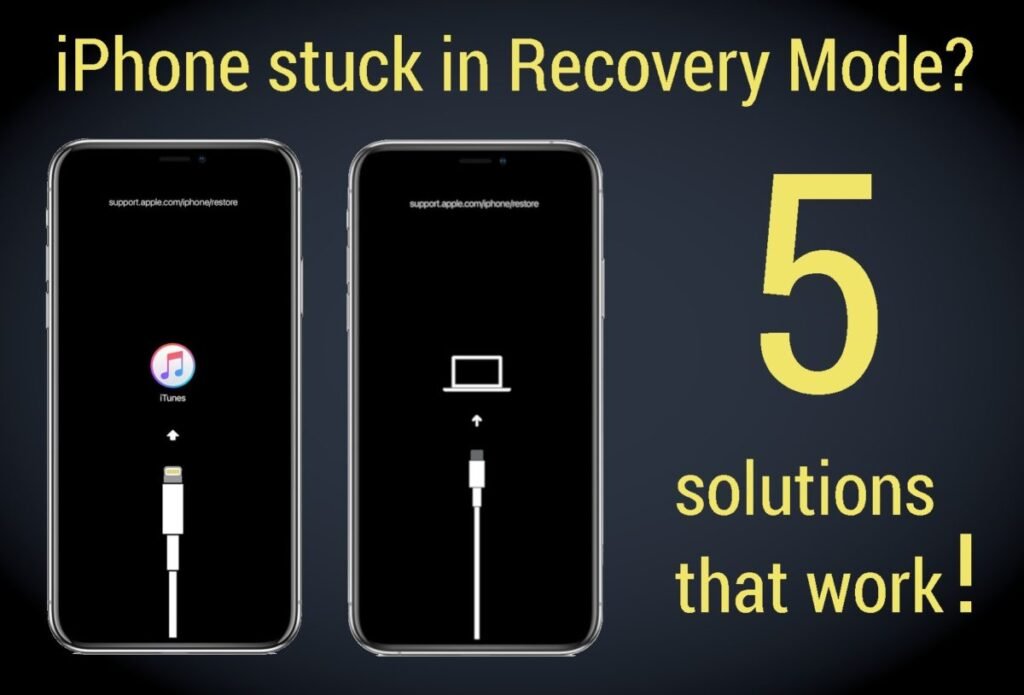
After a couple of trials and errors, I zeroed in on the best methods that work like a charm on any Apple device stuck in recovery mode. I also figured out a few important do’s and don’ts, best practices so that we don’t face any hurdles along the way.
After getting rid of my iPhone recovery problem, I decided that the best way to give back to the community is by compiling a ‘best of’ solution list for the iPhone stuck in recovery problem and explain them comprehensively in a blog post like this. These are all 100% working methods. So, this should take away all the worries out of your head.
Apart from Recovery Mode, there are other such modes an iPhone can get stuck in like the Boot Loop and the DFU Mode. Here’s how to tell the difference between the three.
Whatever is your device’s condition, count on at least one of these work-arounds to see you home safely. This article discusses five ways to exit Recovery Mode, irrespective of your iPhone model or iOS version. You can use these same methods for an iPad stuck in recovery mode as well.
How to Exit Recovery Mode on an iPhone – Five Methods
The solution to get your iPhone out of Recovery Mode may depend on the reason it went into Recovery Mode. As a result, the solutions vary as follows:
- Force Restart Your iPhone
- Use Third Party Softwares
- Restore iPhone to Factory Settings
- Put iPhone in DFU Mode
1. Force Restart your iPhone to exit Recovery Mode
The first method involves using the physical buttons on your iPhone/iPad to forcefully restart your device. If you succeed in force restarting your iPhone, you can retain all your data same as it was just before the iPhone got stuck in Recovery Mode.
There are different ways to ‘force restart’ each iPhone and iPad as the positions of buttons change over time with newer iterations of these devices.
As a precaution, remove all the cables and connections from your iPhone before proceeding to force restart your device.
How to Force Restart iPhone 14, iPhone13, iPhone 12, iPhone 11, iPhone X and iPhone 8
Here is the proper method to restart all the iPhones ranging from iPhone 8 to iPhone 12, iPhone 13 and beyond. This covers the Plus, Pro and Max versions as well.
- Press and release the Volume Up button then press and release the Volume Down button immediately, one after the other.
- Just after that, quickly hold down the Power button by pressing it in indefinitely.
- Do not let go of the Power button until you see a completely black screen followed by the Apple logo. Release the button after that, as your iPhone restarts.
In other words, two short presses of the Volume Up and Down buttons followed by a long press of the Power button, should do the trick as shown in the picture.
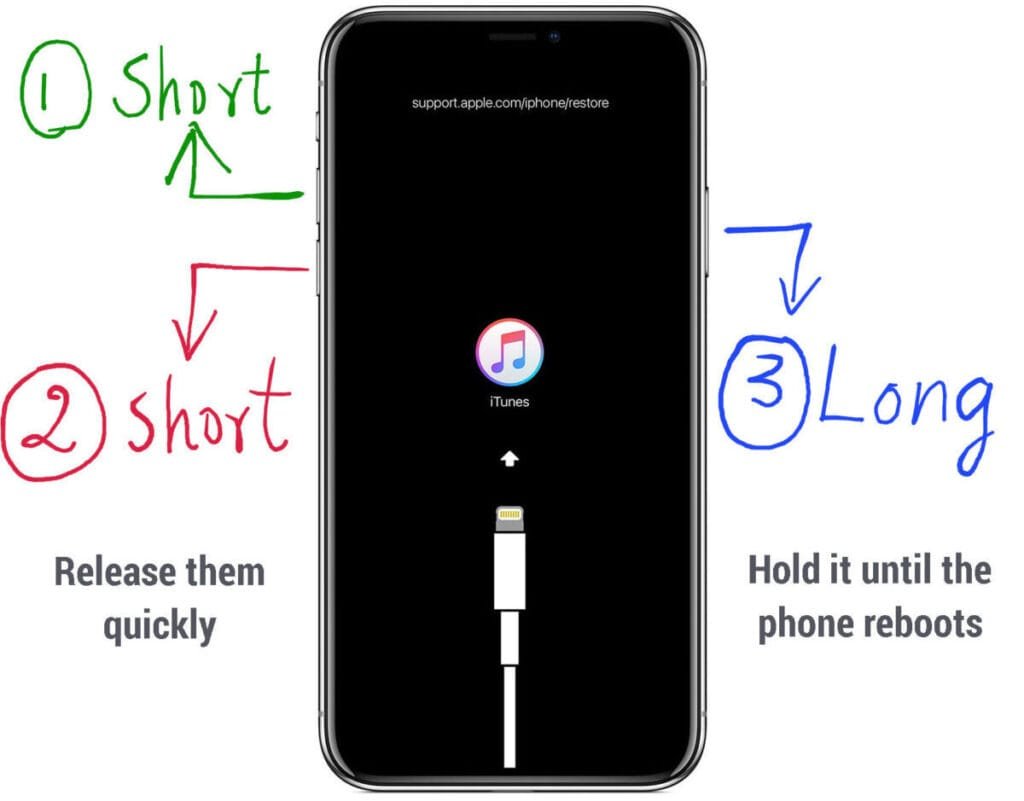
How to Force Restart iPhone 7 and iPhone 7 Plus
In the case of the iPhone 7 and iPhone 7 Plus, force restarting is fairly straight forward. Simply press and hold the Power button and Volume Down button simultaneously for more than 10 seconds until your iPhone goes blank and the Apple logo appears.
How to Force Restart iPhone 6s and older models
Force restarting the iPhone 6s and older iPhone models is also simple. All you have to do is find the Power button as it is located on top for some models and on the right side for other models.
- Once you find the Power button on your iPhone hold down the Home button and then press the Power button to hold that too.
- Now you are holding both the Home button and the Power button simultaneously. Do this until your iPhone reboots with the Apple logo.
How to Force Restart iPads without Home button such as iPad Pro 3rd, 4th and 5th Gen
Many iPad models such as the 3rd, 4th and 5th generations of iPad Pro and the later models of iPad mini and iPad Air do not have Home buttons. Therefore, they require a special approach to force restart them.
Incidentally, the method required to restart these iPads is the same as the method I gave earlier for iPhone 12, iPhone 11 etc. It goes like this. Press and release the Volume Up followed by the Volume Down button, then immediately long press the Power button until the device reboots with the Apple logo.
How to Force Restart iPads with Home button such as iPad Air 2, iPad mini 2, 3, 4 and iPad Pro 1, 2
All relatively older models of iPad have a mechanical Home button you can press down. This comes in handy for forcefully restarting a device when it goes into Recovery Mode.
It is an easy process. Simply hold down the Home button. While still holding it, now press down the Power button and do not release them till the device reboots. It is the same as for iPhone models like iPhone 6s or below.
2. Recovery Software for an iPhone stuck in Recovery Mode
You can also take the help of Recovery tools such as ReiBoot to retrieve your iPhone stuck in recovery Mode without suffering any data loss. These software tools have a very high success rate and most of them are up to date to tackle the latest iOS versions.
While some of these tools are paid software, all of them are free to download and they gracefully allow the user to use the exit Recovery Mode function for free.
So, there is no need to worry unless yours is a more complicated problem. Let’s explore some of these software.
1. ReiBoot to exit Recovery Mode on iPhone
Tenorshare’s ReiBoot is the best iPhone problem solving software out there. It was previously called RecBoot. It is available for both Windows and Mac. The Pro version can clear almost all the problems an average iPhone user may come across. The good news is that you are not required to purchase ReiBoot Pro to repair an iPhone stuck in Recovery Mode.
How to use ReiBoot to exit recovery mode on iPhone.
Download and install ReiBoot for Windows or ReiBoot for Mac from Tenorshare’s official website.
- Open ReiBoot and connect your iPhone/iPad to the computer using the genuine USB cable.
- Give it a moment to detect that your device is in Recovery Mode.
- You will see an option “Exit Recovery Mode” in that ReiBoot window. Click that option and wait for the iPhone to reboot. When you see your lock-screen, you can use your iPhone again normally.
- All your personal data should be fine. But to avoid future data losses, quickly connect to iTunes and take a full back up of your device. That way you will be ready to face any new scares your iPhone may give you.
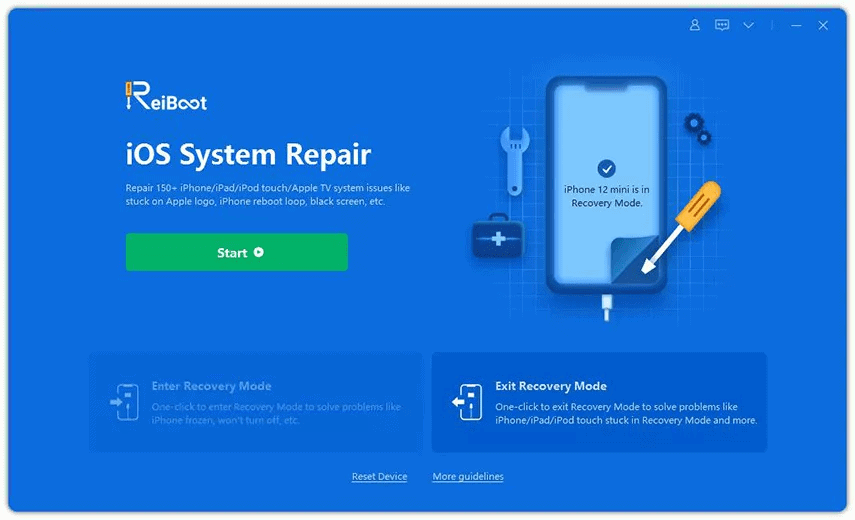
- How to do iPhone IMEI Check for Blacklist Status for stolen iPhones
- How to take a Screenshot on iPhone 12 and iPhone 13
2. iMyFone Fixppo to exit Recovery Mode on iPhone
iMyFone’s Fixppo is another great software you can use to normalize your iPad/iPhone stuck in Recovery Mode without any data loss. Much like ReiBoot, it is a tool for repairing Apple device errors and does a great job too. The Paid Version of Fixppo offers many additional features which we would not be needing in this operation. It runs well in both Mac and Windows.
How to use iMyFone Fixppo to exit Recovery Mode.
- Download and install Fixppo for Windows or Mac from iMyFone.
- Open the software and close the ‘message center’ pop-up that shows up.
- In the Fixppo window, now you’ll see three buttons:
- Standard Mode
- Advanced Mode and
- Enter/Exit Recovery Mode.
- Choose the ‘Enter/Exit Recovery Mode’ option. Now it prompts you to please connect your device. Using a genuine USB cable connect your iPhone/iPad and click on the ‘Exit Recovery Mode’ button at the bottom right.
- Within a few moments, your device boots up with Apple logo and returns to your normal lock-screen without losing your personal data.
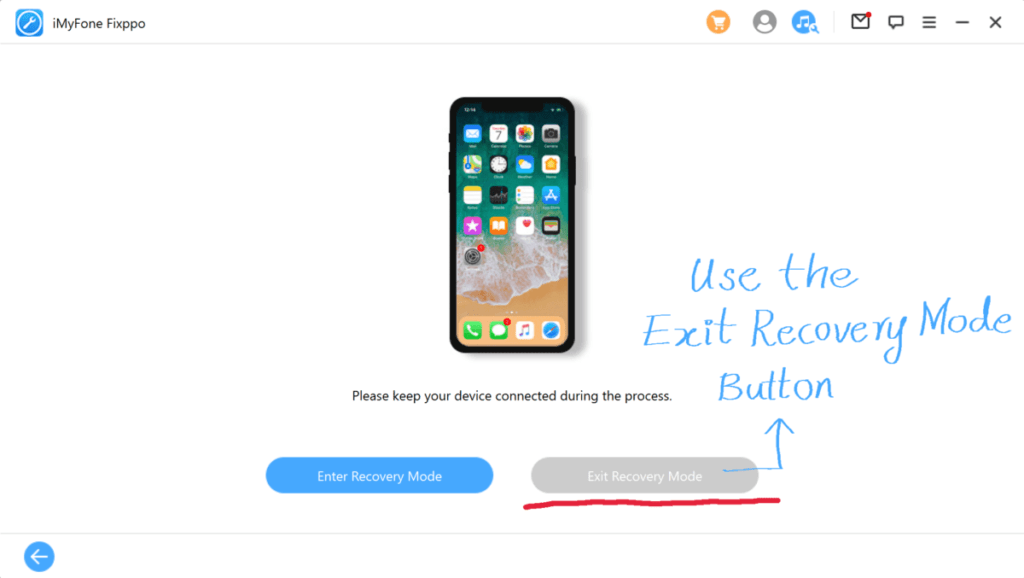
3. RecBoot and other Tools for iPhone stuck in Recovery Mode
In addition to Tenorshare’s ReiBoot and iMyFone’s Fixppo, there are many more software tools which more or less provide the same features. Among them, a software called RecBoot is one of the oldest and most used iPhone recovery software until it recently started giving troubles on 64 bit operating systems.
iToolab FixGo, UltFone iOS System Repair and Dr.Fone – System Repair (iOS) are three more iPhone/iPad repairing software that can help you when in need. Do check them out, as their process is very similar to both ReiBoot and Fixppo.
3. Restoring an iPhone stuck in Recovery Mode using a Computer
If all the previous methods fail to resolve your issue, you may need to restore your iPhone using your Mac or Windows PC. This one is a painful step to those who have precious data left on the iPhone without any backups.
Restoring your iPhone to Factory settings may fix the problem but all your personal data is going to be lost.
However if you do have a backup of your personal data, then you can restore it later after the recovery mode problem is solved.
How to restore an iPhone stuck in Recovery Mode using a computer
- Connect your computer and your iPhone using the genuine USB cable.
- If you are using a Mac, on MacOS Catalina or later versions, then open Finder and select your iPhone from the sidebar.
- If you are using a Windows PC or a Mac running a MacOS version earlier than Catalina, then open iTunes and select the iPhone icon from the top.
- After the computer recognizes the iPhone, select Restore iPhone. A Pop up shows up asking if you are sure you want to restore iPhone to factory settings. Confirm that by selecting the Restore and Update option.
- This step deletes all the data from your device essentially making it how it was when new.
- You may need to wait about 30 minutes or more while your computer downloads the latest version of iOS and updates your iPhone. In the meanwhile, make sure the connection between your iPhone and computer is not disturbed.
- After the whole process is complete the iPhone starts up with the Hello screen saying “swipe up to open” or “slide to open“. Follow all the instructions thoroughly. When it prompts you to restore from a backup do so by selecting the right options and continue till your data is completely recovered.

Delete Corrupt iOS Downloads from your Computer
The Recovery Mode might also be triggered when the iOS files downloaded on your computer are corrupt. Due to these corrupt iOS files, the update process gets messed up and your iPhone go into Recovery Mode.
In this case, using your computer to restore and update your iPhone may once again lead to Recovery Mode. This is because your computer tries to reinstall iOS using the same iOS files it had previously downloaded. The only way to get around this is to find and delete those downloaded files. This prompts your computer to download a fresh copy of iOS from online.
On a Windows PC
- Open File Explorer and enable Hidden Files.
- Go to
- Users > (Admin Name) > AppData > Roaming > Apple Computer > iTunes > iPhone Software Updates.
- Delete the update files in that folder.
On MacOS
- Open Finder, on the Go tab in menu bar, hold down the Option key and select Library from the drop-down.
- Inside that find iTunes > iPhone Software Updates and delete the files.
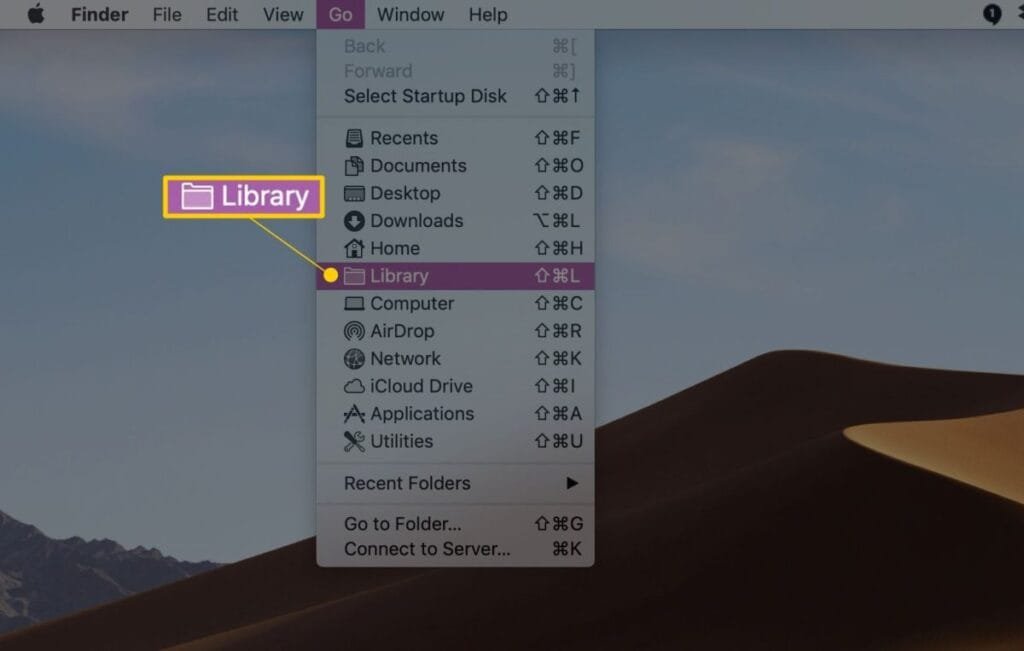
After erasing all the updates of iOS from your computer, whether Mac or PC, now you need not worry about the corrupt update files that caused Recovery Mode. You can now restore your iPhone using a computer to exit Recovery Mode. To do that follow the earlier method I showed above.
4. Restore your iPhone using DFU Mode
If restoring your iOS using a computer did not work for you, there might be a firmware problem with your iPhone. You can get rid of that problem by updating your device firmware through DFU Mode. For this you need to learn how to put your iPhone/iPad in DFU Mode.
DFU Mode means ‘Device Firmware Upgrade Mode’. It is a special mode to upgrade your firmware safely.
DFU Mode is just like Recovery Mode except you do not see any symbols or messages on the screen. Your iPhone just goes completely blank when in DFU Mode.
During the DFU Mode, your computer recognizes your iPhone as in Recovery Mode. Do not fret over that too long, as that is the way it is supposed to be. Apparently, the way to put your iPhone and iPad in DFU Mode changes with each model.
How to put iPhone 13, iPhone 12, iPhone 11, iPhone X and iPhone 8 in DFU Mode
Putting the iPhone 8 and later iPhones in DFU mode is very similar to Force Restarting them. There is just a tiny additional step you need to follow for putting it in DFU Mode.
- Connect the iPhone and computer with the genuine USB cable. Open iTunes in Windows or Finder in MacOS.
- Short press the Volume Up button. Then short press the Volume Down button. Now, quickly hold down the Power button.
- Keep holding the Power button until the screen goes black. As soon as you see the black screen, hold down the Volume Down button while still holding the Power button.
- Keep pressing both the buttons for at least 5 seconds.
- After that release the Power button but keep holding the Volume Down button until the screen goes completely black. Release all buttons immediately.
That’s it, you have successfully put your iPhone in DFU Mode.
iPhone failed go to DFU Mode?
However, if you keep holding it past the black screen then your iPhone gets stuck in Recovery Mode again. That means, if you see the Apple logo or Recovery Mode logo this attempt to put the iPhone in DFU Mode has failed.
In that case, repeat the process from step 1. You will become successful in putting your iPhone in DFU Mode, eventually. At that moment, give the computer some time to detect and download the required firmware.
From there start following iTunes’ instructions. At the end of it all, you should be able to restore your iPhone. Later, force restart your iPhone to exit DFU Mode. For help, follow the above guides to force restart your iPhone.
How to put an iPhone 7 in DFU Mode
- Connect it to the computer using a genuine USB cable and open iTunes or Finder.
- Long press the Power button along with the Volume Down button.
- Keep holding them both for 8 seconds. After that, release the Power button but keep holding the Volume Down button until a dark screen appears. Release all buttons immediately.
- You are successfully in DFU Mode.
However, if you see the Apple logo or Recovery Mode logo then this attempt to put the iPhone in DFU Mode has failed. In that case, repeat the process from step 2. When you are eventually successful in putting your iPhone in DFU Mode, give the computer some time to detect and download the required firmware.
From there start following iTunes’ instructions. At the end of it all, you should be able to restore your iPhone. Later, force restart your iPhone to exit DFU Mode. For help, follow the above guides to force restart your iPhone 7.
How to put the iPhone 6S and earlier iPhones in DFU Mode
- Connect your iPhone using the original USB connector to the computer and open iTunes or Finder.
- Long press the Power button along with the Home button.
- Keep holding them both for 8 seconds, after that release the Power button but keep holding the Home button until a dark screen appears. Now, release all buttons immediately.
- You are successful.
However, if you see the Apple logo or Recovery Mode logo then this attempt to put the iPhone in DFU Mode has failed. In that case, repeat the process from step 2. When you are eventually successful in putting your iPhone in DFU Mode, give the computer some time to detect and download the firmware.
From there start following iTunes’ instructions. At the end of it all, you should be able to restore your iPhone. Later, force restart your iPhone to exit DFU Mode. For help, follow the above guides to force restart your iPhone.
5. Contact Apple Support to retrieve your iPhone
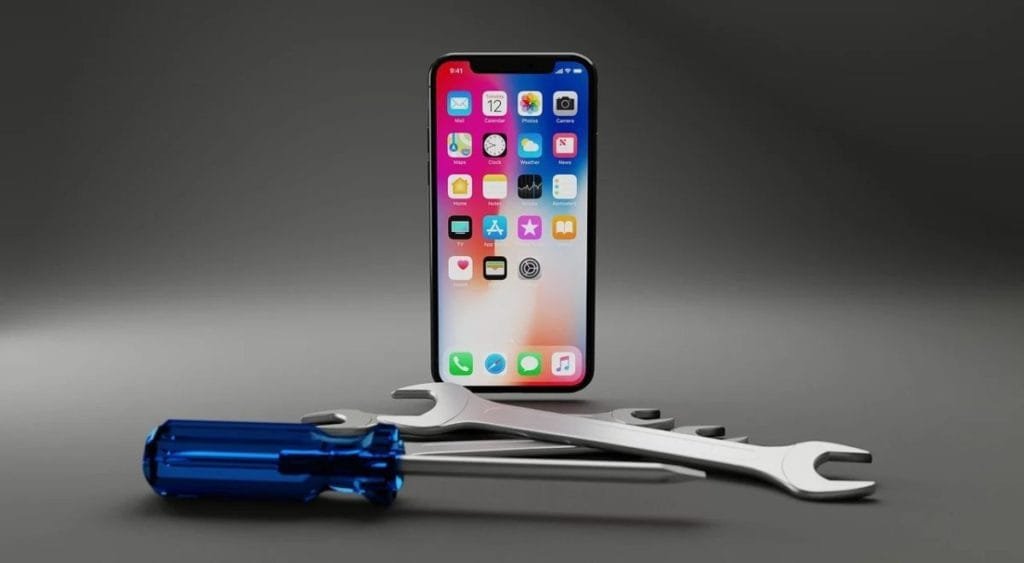
Sometimes the luck is just not on your side. If none of the solutions are working for you, in spite of your best efforts, consider this argument. Since we have already restored both the software and the firmware on your iPhone, the only culprit left now is a hardware failure.
At this point we must assume that your iPhone has a hardware problem.
Contacting Apple is the way to go now. Make an appointment for a device repair with Apple Support and detail your problem to their professional. Also, learn how to check your iPhone’s coverage using Apple Serial Number on Apple’s website and other third party websites.
Conclusion
In this article we learned that there is no need to panic if your iPhone goes into recovery mode. We learnt the 5 easiest methods to get iPhone out of recovery mode in detail. With these solutions, you can be very confident in any future critical situations.
If your iPhone works for sometime and goes into Recovery Mode again and this process repeats, make sure to take a full backup on iTunes when you have got the chance. This way you can retrieve your personal data once the hardware issue is resolved.
Make sure to sound any of your concerns in the comment section. Hope you were able to retrieve your iPhone back using my work-arounds. If you were, please like and follow our Facebook, Twitter and Instagram pages.











Thank you for this information. I will surely use this tool and Acethinker Fone Keeper so that I can fix something like this problem again in the future.
Thanks. Reiboot helped me get out of recovery.